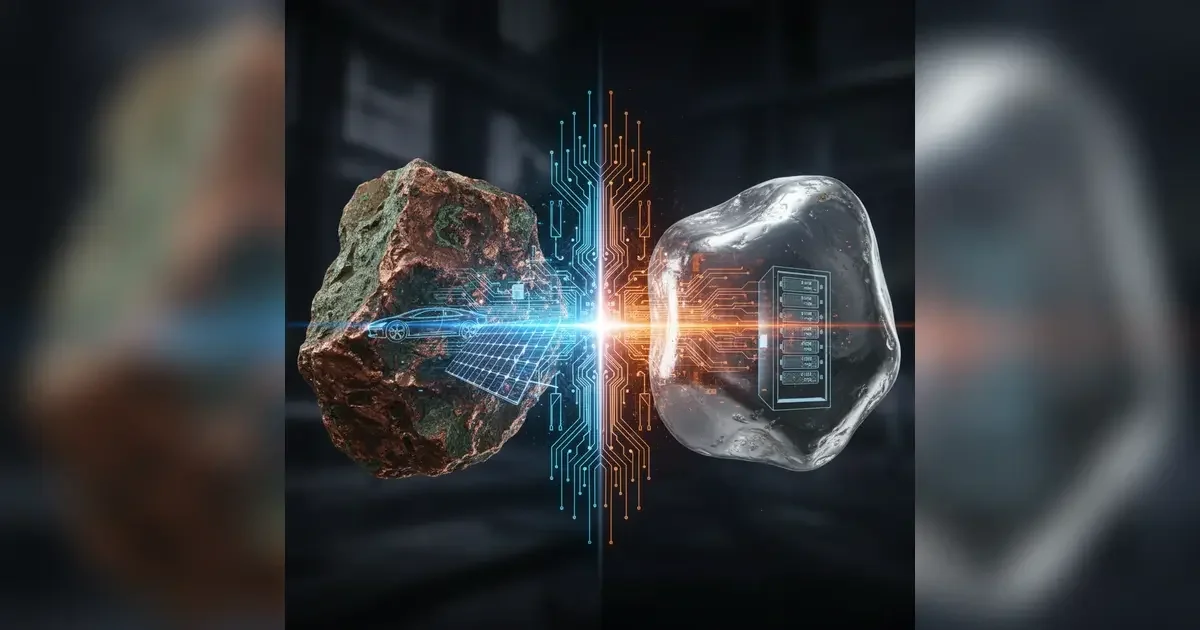Let’s be brutally honest. When we talk about the future of tech, we get excited about the sexy stuff: mind-bending AI algorithms, quantum computers, and sleek electric vehicles that glide silently down the road. We romanticize the code, the silicon, and the lithium-ion batteries that power our shiny new world.
But that’s like admiring a bodybuilder’s biceps while completely ignoring their skeleton and circulatory system.
The unsexy, uncomfortable truth is that our entire digital and green future is built on a foundation of two ancient, almost boring metals: silver and copper. These aren't the hot new elements on the block. They’re the metals your great-grandmother wore as jewellery or cooked with in her kitchen. And right now, they are more critical to our technological progress than ever before. Forgetting them is not just an oversight; it’s a critical failure to understand how our world actually works.
Copper: The Gritty, Overworked Nervous System of Everything
Think of copper as the ultimate blue-collar worker of the materials world. It’s not the flashiest, but it shows up every single day and does the heavy lifting. Its superpower? Conductivity. It’s the second-best electrical conductor of all metals, but it's cheap and abundant, making it the undisputed champion for moving electricity and data from point A to point B.
Every single time you:
- Charge your smartphone…
- Flick on a light switch…
- Connect to your Wi-Fi…
- Stream a movie from a data center hundreds of kilometers away…
…you are relying on copper. It’s the wiring in your walls, the guts of your electronics, and the literal backbone of the internet and the power grid. It's the planet's circulatory system for electrons.
Now, here’s where it gets interesting. The two biggest tech revolutions of our time—the green energy transition and the AI boom—are ridiculously copper-hungry.
An electric vehicle, like the ones from Tata Motors or Ola Electric, needs up to four times more copper than a regular petrol car. Why? Because it’s basically a computer on wheels powered by a massive battery, all connected by a web of copper wiring. A solar farm or a wind turbine needs tonnes of the stuff to generate power and send it to your home. The companies at the forefront of this shift, like Adani Green Energy and Tata Power Solar, are essentially massive consumers of copper.
And AI? Those massive data centers run by Google, Amazon, and Microsoft that train models like ChatGPT are energy black holes. All that power, and all the data being processed, flows through miles and miles of copper cables and busbars. The AI revolution runs on copper.
Silver: The High-Performance Specialist
If copper is the reliable workhorse, silver is its super-talented, slightly more expensive sibling. It holds the crown for being the single best electrical and thermal conductor on the planet. It’s also highly reflective.
This premium performance means silver is used where efficiency and reliability are non-negotiable. It’s the secret sauce in a surprising number of high-tech applications:
- Solar Panels: That metallic grid on the surface of a solar panel? That’s silver paste. Its job is to capture the electrons knocked loose by sunlight and channel them into an electric current. No silver, no solar power. It’s that simple.
- Electronics: It’s used in everything from the conductive inks for printed circuit boards (PCBs) in your smartphone to critical contacts and switches. Every time you tap your screen, you're interacting with a product that depends on silver.
- 5G Technology: High-frequency signals require top-tier components to minimize signal loss. Silver is used to coat connectors and components in 5G base stations built by companies like Reliance Jio and Airtel, ensuring your connection is fast and stable.
The demand for silver isn't just about making things work; it's about making them work better. As our technology becomes more sophisticated and miniaturized, the need for a high-performance conductor like silver only grows.
The Squeeze Is Real and the Giants Are Thirsty
So, what's the bottom line?
The companies we celebrate as innovators—Apple, Samsung, NVIDIA, Tesla—are, at their core, massive logistics operations for turning raw materials like copper and silver into functional magic. India’s own ambition to become a global electronics manufacturing hub through schemes like "Make in India" is fundamentally a bet on securing a stable supply of these metals.
This isn't a problem for the distant future. The demand is surging now. Every new EV sold, every solar panel installed, and every data center built tightens the squeeze on the global supply.
We love to talk about the genius of the engineer and the vision of the CEO. But maybe it’s time we gave a little credit to the humble, unsexy metals that make it all possible. Because without copper and silver, our glittering high-tech future is just a fantasy. They are the real MVPs, and the companies that understand this are the ones who will ultimately win.
